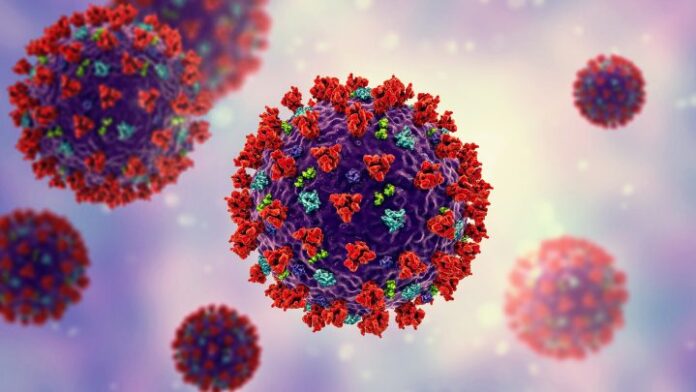As Canada heads towards a sixth wave of COVID-19 with rising cases and hospitalizations across the country, health experts are stressing the need to continue masking and boosting the population.
Latest modelling by the Public Health Agency of Canada (PHAC) released on Friday showed a 34-per cent increase in daily average case counts as of March 30, indicating a resurgence is underway.
The latest surge is being partially driven by the highly transmissible BA.2 subvariant of Omicron, which is now the dominant version of the virus in several provinces, as well as the lifting of COVID-19 restrictions, including masking and proof of vaccination, in most settings, federal health officials say.
COVID-19: As Shanghai goes into lockdown, what will 6th wave look like in Canada?
Experts are frustrated that the mask mandates, one of the key tools in tackling the virus, were taken off too quickly by provinces — and that decision needs to be reconsidered before the situation gets out of control.
“Masks need to go back on very quickly. Otherwise we’re going to have a lot more cases on our hands,” said Dr. Kashif Pirzada, an emergency physician in Toronto.
Mandate or no mandate, Tim Sly, an epidemiologist and professor emeritus in the School of Public Health at Ryerson University, said the messaging around giving people the freedom to take their mask off and “go back to normal “ was a mistake.
Read more:
Toronto’s top doctor encourages masks in public spaces as Ontario sees 6th wave of COVID-19
“I think we should be encouraging people to wear a mask in a crowded situation, subway or a sports arena or in a large classroom … or a shopping mall,” he said.
COVID-19: People should continue to wear masks despite relaxed mandates, says Tam
Dr. Donald Vinh, an infectious disease specialist and medical microbiologist at the McGill University Health Centre (MUHC) agrees, saying he is hopeful “common sense” will prevail in making future decisions.
“What five waves have previously told us is that masks work, vaccinations work, ventilation works. And if that works for the five previous waves, it’s going to work for the sixth wave, and that’s what we need to do,” he told Global News.
Canada’s vaccination rate is another issue. Even though more than 80 per cent of the population is fully vaccinated with the two-dose schedule, only 47 per cent have received a third dose.
Trending Stories
Canada to punish ‘close associates’ of Russia, Belarus with new sanctions
Satellite images show 45-foot-long trench at grave site in Bucha after Russia’s attack
With waning immunity and the more transmissible BA.2 variant taking hold, experts say two doses are just not enough for protection and boosters should be a priority to combat the current Omicron spike.
“We need to get rid of this idea that being fully or adequately vaccinated is anything less than three. That’s wrong,” said Vinh.
Meanwhile, federal health officials are also considering recommendations for a fourth dose, or a second booster, for the elderly population. This comes as U.S. regulators last week approved a fourth dose for Americans 50 and older if it’s been at least four months since their last vaccination.
COVID-19: Canadians aged 50+ should get 4th dose to protect against severe disease, Tam says
Canada’s National Advisory Committee on Immunization (NACI) has previously recommended that moderately or severely immunocompromised Canadians may receive a second booster or fourth shot at least six months after their last dose.
“The first two and the third one, it was enormous in terms of the protection, but the difference between the third one and the fourth one is very small actually,” said Sly.
This is where the vaccines that specifically target variants, which are still in clinical trials, will be extremely helpful, said Omar Khan, a professor of biomedical engineering and immunology at the University of Toronto.
“The best strategy to pursue is potentially an updated vaccine,” he said. “Going forward, this is going to be tied really closely to a pathogen surveillance.”
According to latest modelling, Canada is preparing for two key scenarios.
The first is the most likely scenario, in which COVID-19 continues to resurge in small, manageable waves. The second, less likely option, is that a new, severe and vaccine-evasive strain of the virus could emerge, which could substantially impact the healthcare systems.
Other countries are also seeing similar trends as the virus keeps evolving with new variants.
Last week, the World Health Organization (WHO) warned of a new strain, called XE, which is a recombination of Omicron’s BA.1 ad BA.2 subvariants. It is believed to be 10 per cent more transmissible than BA.2, according to the WHO.
“Because we’re giving COVID a chance for this to happen, the ball is no longer in our court. The ball is now in the virus’s court,” said Vinh.
Experts warn ‘stealth’ Omicron fuelling start of Canada’s 6th COVID-19 wave
While another lockdown or re-imposition of restrictions does not appear to be on the cards for now, doctors are urging Canadians to remain vigilant — and regardless of public health mandates, continue taking all necessary precautions.
“The governments don’t really have our back anymore,” said Pirzada, who added that hospital staff is grappling with underlying burnout and an increase in admissions.
“This is kind of a do-it-yourself pandemic,” he said.
“If you have any symptoms, stay away and protect other people, wear a mask in indoor spaces, use rapid tests and try to fix the ventilation in places where you’re working or going to school. That’ll go a long way.”
© 2022 Global News, a division of Corus Entertainment Inc.



